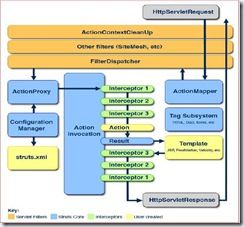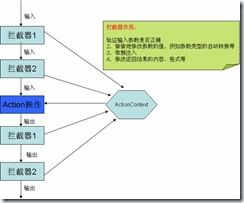Struts2源代码分析之Struts2 Interceptor模式
首先贴出众所周知的Struts工作流程图:
流程解说:
![]() 1、客户端向Servlet容器(如Tomcat)提交一个请求
1、客户端向Servlet容器(如Tomcat)提交一个请求
![]() 2、请求经过一系列过滤器(如ActionContextCleanUp过滤器等)
2、请求经过一系列过滤器(如ActionContextCleanUp过滤器等)
![]() 3、核心控制器被调用,询问ActionMapper来决定请求是否需要调用某个Action
3、核心控制器被调用,询问ActionMapper来决定请求是否需要调用某个Action
![]() 4、如果ActionMapper决定需要调用某个Action,核心控制器把控制权委派给ActionProxy (备注:JSP请求无需调用Action)
4、如果ActionMapper决定需要调用某个Action,核心控制器把控制权委派给ActionProxy (备注:JSP请求无需调用Action)
![]() 5、ActionProxy通过Configuration Manager询问框架的配置文件(struts.xml),找到需调用的Action类
5、ActionProxy通过Configuration Manager询问框架的配置文件(struts.xml),找到需调用的Action类
![]() 6、ActionProxy创建一个ActionInvocation的实例
6、ActionProxy创建一个ActionInvocation的实例
![]() 7、 ActionInvocation负责调用Action,在此之前会依次调用所有配置的拦截器
7、 ActionInvocation负责调用Action,在此之前会依次调用所有配置的拦截器
![]() 8、Action执行完毕,ActionInvocation负责根据结果码字符串在struts.xml的配置中找到对应的返回结果
8、Action执行完毕,ActionInvocation负责根据结果码字符串在struts.xml的配置中找到对应的返回结果
l 寻找核心控制器,以下是struts2.3核心控制器StrutsPrepareAndExecuteFilter的关键代码:
public void doFilter(ServletRequest req, ServletResponse res, FilterChain chain) throws IOException, ServletException {
HttpServletRequest request = (HttpServletRequest) req;
HttpServletResponse response = (HttpServletResponse) res;
try {
prepare.setEncodingAndLocale(request, response);
prepare.createActionContext(request, response);
prepare.assignDispatcherToThread();
if ( excludedPatterns != null && prepare.isUrlExcluded(request, excludedPatterns)) {
chain.doFilter(request, response);
} else {
request = prepare.wrapRequest(request);
//根据请求上下文获得一个ActionMapping
ActionMapping mapping = prepare.findActionMapping(request, response, true);
if (mapping == null) {
boolean handled = execute.executeStaticResourceRequest(request, response);
if (!handled) {
chain.doFilter(request, response);
}
} else {
//根据ActionMapping执行该Action,里面还隐藏着很多代码,此处execute是当前类的一个属性“protected ExecuteOperations execute;”,通过跟踪我们发现” execute.executeAction”方法执行的实际上是另一个Dispatcher类的serviceAction方法
execute.executeAction(request, response, mapping);
}
}
} finally {
prepare.cleanupRequest(request);
}
}
l 寻找Dispatcher类的serviceAction方法:
public void serviceAction(HttpServletRequest request, HttpServletResponse response, ServletContext context,
ActionMapping mapping) throws ServletException {
//…省略
String timerKey = "Handling request from Dispatcher";
try {
UtilTimerStack.push(timerKey);
String namespace = mapping.getNamespace();
String name = mapping.getName();
String method = mapping.getMethod();
Configuration config = configurationManager.getConfiguration();
//创建代理ActionProxy
ActionProxy proxy = config.getContainer().getInstance(ActionProxyFactory.class).createActionProxy(
namespace, name, method, extraContext, true, false);
request.setAttribute(ServletActionContext.STRUTS_VALUESTACK_KEY, proxy.getInvocation().getStack());
//执行该ActionProxy
// if the ActionMapping says to go straight to a result, do it!
if (mapping.getResult() != null) {
Result result = mapping.getResult();
result.execute(proxy.getInvocation());
} else {
proxy.execute();
}
} catch (Exception e) {
sendError(request, response, context, HttpServletResponse.SC_INTERNAL_SERVER_ERROR, e);
} finally {
UtilTimerStack.pop(timerKey);
}
}
l 寻找代理Action的execute方法[ActionProxy是一个接口,我们观察他的一个缺省实现DefaultActionProxy]:
public class DefaultActionProxy implements ActionProxy, Serializable {
public String execute() throws Exception {
//…省略
try {
UtilTimerStack.push(profileKey);
//每个ActionProxy会持有一个唯一的ActionInvocation, struts2的Interceptor模式就在这里体现
retCode = invocation.invoke();
} finally {
if (cleanupContext) {
ActionContext.setContext(nestedContext);
}
UtilTimerStack.pop(profileKey);
}
return retCode;
}
}
l 寻找ActionInvocation
public class DefaultActionInvocation implements ActionInvocation {
//每个ActionInvocation对象持有一个InterceptorMapping对象组成的迭代器.
//根据前面的工作原理我们知道代理Action在执行真实Action的前后要执行Interceptor.这里就是struts2 Interceptor模式所在
protected Iterator<InterceptorMapping> interceptors;
public String invoke() throws Exception {
try {
if (interceptors.hasNext()) {
//从迭代器取出一个InterceptorMapping
final InterceptorMapping interceptor = (InterceptorMapping) interceptors.next();
String interceptorMsg = "interceptor: " + interceptor.getName();
UtilTimerStack.push(interceptorMsg);
try {
//从InterceptorMapping取出Interceptor执行其intercept方法,并将当前ActionInvocation实例传递给拦截器对象,核心所在,
//我们下面马上去看一个Interceptor的实现
resultCode = interceptor.getInterceptor().intercept(DefaultActionInvocation.this);
}
finally {
UtilTimerStack.pop(interceptorMsg);
}
} else {
resultCode = invokeActionOnly();
}
return resultCode;
}
finally {
UtilTimerStack.pop(profileKey);
}
}
public String invokeActionOnly() throws Exception {
return invokeAction(getAction(), proxy.getConfig());
}
}
l 寻找Interceptor
public class AliasInterceptor extends AbstractInterceptor {
@Override public String intercept(ActionInvocation invocation) throws Exception {
//执行拦截器业务操作1.
//执行拦截器业务操作2.
return invocation.invoke();//通过ActionInvocation回调invoke方法,再次取出下一个InterceptorMapping
}
}
拦截器模式分析:
以上组后两个步骤体现出拦截器模式,为了便于理解,我用图示说明
解决问题:我们有个一个Action和一组拦截器,要拦截对对Action对象execute方法的执行,以使得在Action对象执行前后可以有机会执行拦截器,达到如下效果图:
实现流程:
流程说明:
1.ActionInvocation发起invoke调用,迭代器中有没有下一个拦截器Mapping,迭代器中有下一个拦截器Mapping,取出该拦截器并执行它的intercept方法,同时将当前实例传递给该方法[红色圆形]
2.执行第一个拦截器的拦截业务,执行完毕后调用上一步传递进来的ActionInvocation实例引用的invoke方法,再次发起对ActionInvocation.invoke的第二次调用[有点递归的意思J]
3.程序流程再次回调invoke方法,和第一部操作一样判断迭代器中有无下一个拦截器Mapping,有的话取出该拦截器并执行它的intercept方法,同时将当前实例传递给该方法[红色圆形]
4.执行第二个拦截器的拦截业务,执行完毕后调用上一步传递进来的ActionInvocation实例引用的invoke方法,再次发起对ActionInvocation.invoke的第三次调用[有点递归的意思J]
5.程序流程再次回调invoke方法,和第一部操作一样判断迭代器中有无下一个拦截器Mapping,但是现在迭代器已经到达末尾了,没有拦截器可以被调用执行,因此程序执行else部分【请观察上面贴出的ActionInvocation的代码】,执行真正的Action实例。
6.真实的 Action执行完毕后程序回到地4步的拦截器里面执行回调代码处,程序继续向下执行拦截器的后半部分代码[当然可能没有代码],由此看出对于当前这个拦截器而言,Action执行前和执行后都经过了该拦截器【想想既然如此我们可以在拦截器里做些什么?参数赋值、文件上传…】
7.当前拦截器的后半部分代码执行完了以后,程序回到第3步调用拦截器的intercept方法处继续执行,由此代码又回到了ActionInvocation,此处程序不在执行 else部分【请观察上面贴出的ActionInvocation的代码】,因为执行时的上下文环境中迭代器是有下一个拦截器的。故方法直接执行结束。
8.上一步的ActionInvocation.invoke执行完毕后继续程序回到第2步的拦截器里面执行回调代码处,程序继续向下执行拦截器的后半部分代码[当然可能没有代码],由此看出对于当前这个拦截器而言,Action执行前和执行后都经过了该拦截器【想想既然如此我们可以在拦截器里做些什么?参数赋值、文件上传…】
9.当前拦截器的后半部分代码执行完了以后,程序回到第1步调用拦截器的intercept方法处继续执行,由此代码又回到了ActionInvocation,此处程序不在执行 else部分【请观察上面贴出的ActionInvocation的代码】,因为执行时的上下文环境中迭代器是有下一个拦截器的。故方法直接执行结束。至此嗲用结束。
我们来简化一下下拦截器模式流程图:
时间紧张,代码不再示范,我们看看这位朋友的博客上的代码示范:
http://www.cnblogs.com/west-link/archive/2011/06/22/2086591.html
拦截器模式为我们提供了一种拦截方法调用或消息的途径,整个过程是自动的、透明的,下面是一个简单的拦截器示意图:
从图中可以看到,拦截器可以访问到方法调用的输入参数和返回结果,这样的话,拦截器能做的事儿就多啦,比如:
1、验证输入参数是否正确
2、偷偷地修改参数的值,例如参数类型的自动转换等
3、依赖注入
4、修改返回结果的内容、格式等
下面是一个包含我们要拦截的方法的类:
public class Action{
// 拦截器集合的迭代器
private Iterator interceptors;
// 输入参数
private Parameter param;
// 返回结果
private Result result;
// 构造函数
public Action(Parameter param);
// 这个方法是我们要拦截的(具体实现见下面)
public Result invoke();
// 其他...
}
下面声明一个拦截器接口:
public interface Interceptor{
public Result intercept(Action action);
}
我们可能会想到以下的拦截方式:
// 先在方法调用之前拦截一下,可以处理输入参数
intercept(param);
// 调用方法
result = action.invoke(param);
// 在方法调用之后再拦截一下,可以处理返回结果
intercept(result);
这种方式的缺点是不能完全地控制方法的调用,比如不能跳过方法的调用而直接返回结果、不能更改所在对象内部的状态等。
下面的实现也能达到方法调用的前后拦截,并且有完全控制该对象的能力
public Result invoke(){
if( interceptors.hasNext() ){
Interceptor interceptor = interceptors.next();
result = interceptor.intercept(this);
}
}
下面我们举几个拦截的具体例子:
// 参数合法性验证拦截器
public ParamInvalidator implements Interceptor{
public Result intercept(Action action){
Paramemter param = action.getParam();
// 确保参数不为null
if(param == null){
addMessege("param is null!");
// 创建一个默认的参数对象
action.setParam(new Paramemter());
}
// 继续调用过程
return action.invoke();
}
}
一般来说,这类拦截器应该放在拦截器集合的最前面,所以,拦截器的被执行顺序是比较重要的!这依赖于具体的实现需求。
如果需求有要求:参数为null时直接返回一个null的结果,停止调用过程,那么我们可以把上面的方法改成这样:
public Result intercept(Action action){
Paramemter param = action.getParam();
if(param == null){
return null;
}
// 继续调用过程
return action.invoke();
}
所以,在所有的拦截器的实现中,action.invoke()这一行代码的位置或者有无非常重要,通过控制它我们就能在调用的前后进行拦截,甚至不调用它!
public interface MoneyAware{
public void setMoney(int money);
}
// 依赖注入拦截器
public DependencyInjector implements Interceptor{
public Result intercept(Action action){
// 如果它实现了MoneyAware接口,那么我们就给它注入5毛钱
if(action instanceof MoneyAware){
action.setMoney(5);
}
// 继续调用过程
return action.invoke();
}
}
从这个拦截器可以看出,我们能修改被拦截对象的内部状态。
// 结果格式化拦截器
public ResultFormater implements Interceptor{
public Result intercept(Action action){
// 先调用要拦截的方法
result = action.invoke();
// 将结果格式化
formatResult(result);
// 返回结果
return result;
}
}
这个拦截器就是方法调用后的拦截,所以这种拦截器被执行的时候被放在调用堆栈的最下面,当其他拦截器执行完后,它才被执行!




